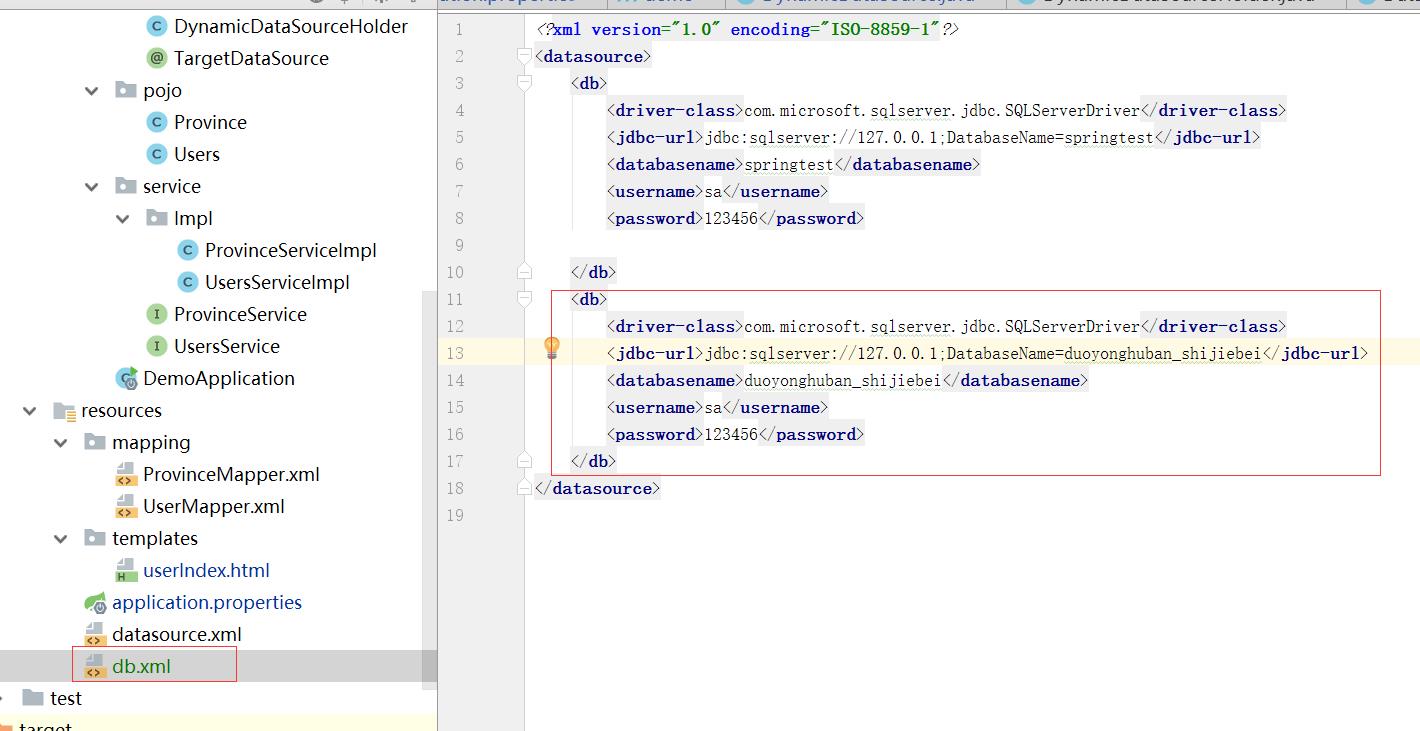spring boot+mybatis 多数据源切换
Posted 易兴
tags:
篇首语:本文由小常识网(cha138.com)小编为大家整理,主要介绍了spring boot+mybatis 多数据源切换相关的知识,希望对你有一定的参考价值。
由于公司业务划分了多个数据库,开发一个项目会同时调用多个库,经过学习我们采用了注解+aop的方式实现的
1.首先定义一个注解类
@Retention(RetentionPolicy.RUNTIME)
@Target(ElementType.METHOD)
public @interface TargetDataSource {
String value();//此处接收的是数据源的名称
}
2.然后建一个配置类,这个在项目启动时会加载数据源,一开始采用了HikariCP,查资料说是最快性能最好的,然后又发现了阿里的druid,这个功能比较全面,而且性能也还可以,最主要他还有监控功能,具体实现看如下代码
package com.example.demo.datasource;
import com.alibaba.druid.pool.DruidDataSource;
import com.alibaba.druid.support.http.StatViewServlet;
import com.alibaba.druid.support.http.WebStatFilter;
import com.example.demo.datasource.DynamicDataSource;
import com.zaxxer.hikari.HikariConfig;
import com.zaxxer.hikari.HikariDataSource;
import lombok.extern.slf4j.Slf4j;
import org.mybatis.spring.annotation.MapperScan;
import org.springframework.beans.factory.annotation.Autowired;
import org.springframework.beans.factory.annotation.Qualifier;
import org.springframework.beans.factory.annotation.Value;
import org.springframework.boot.web.servlet.FilterRegistrationBean;
import org.springframework.boot.web.servlet.ServletRegistrationBean;
import org.springframework.context.annotation.Bean;
import org.springframework.context.annotation.Configuration;
import org.springframework.jdbc.datasource.DataSourceTransactionManager;
import org.springframework.scheduling.annotation.EnableScheduling;
import org.springframework.scheduling.annotation.Scheduled;
import org.springframework.transaction.PlatformTransactionManager;
import org.w3c.dom.NodeList;
import org.w3c.dom.Document;
import org.w3c.dom.Element;
import org.w3c.dom.Node;
import javax.servlet.annotation.WebInitParam;
import javax.servlet.annotation.WebServlet;
import javax.sql.DataSource;
import javax.xml.parsers.DocumentBuilder;
import javax.xml.parsers.DocumentBuilderFactory;
import java.lang.reflect.Field;
import java.lang.reflect.Method;
import java.util.HashMap;
import java.util.Map;
import java.io.File;
import com.alibaba.druid.support.http.StatViewServlet;
/**
* Author: wangchao
* Version:
* Date: 2017/9/11
* Description:数据源配置
* Modification History:
* Date Author Version Description
* --------------------------------------------------------------
* Why & What is modified:
*/
@Configuration
@EnableScheduling
public class DataSourceConfig {
/*@Autowired
private DBProperties properties;*/
@Value("${datasource.filePath}")
private String filePath;//数据源配置
@Bean(name = "dataSource")
public DataSource dataSource() {
//按照目标数据源名称和目标数据源对象的映射存放在Map中
Map<Object, Object> targetDataSources = new HashMap<>();
//查找xml数据连接字符串
targetDataSources=getdataMap(filePath);
//动态获取DBProperties类申明的属性
/*Field[] fields=properties.getClass().getDeclaredFields();
for(int i=0;i<fields.length;i++)
{
targetDataSources.put(fields[i].getName(), getFieldValueByName(fields[i].getName(),properties));
}*/
//采用是想AbstractRoutingDataSource的对象包装多数据源
DynamicDataSource dataSource = new DynamicDataSource();
dataSource.setTargetDataSources(targetDataSources);
//设置默认的数据源,当拿不到数据源时,使用此配置
//dataSource.setDefaultTargetDataSource(properties.getUzaiTravel());
return dataSource;
}
@Bean
public PlatformTransactionManager txManager() {
return new DataSourceTransactionManager(dataSource());
}
/**
*获取数据源集合
*/
private Map<Object, Object> getdataMap(String fiePath)
{
try {
Map<Object, Object> targetDataSources = new HashMap<>();
File xmlFile = new File(fiePath);
DocumentBuilderFactory builderFactory = DocumentBuilderFactory.newInstance();
DocumentBuilder builder = builderFactory.newDocumentBuilder();
Document doc = builder.parse(xmlFile);
doc.getDocumentElement().normalize();
System.out.println("Root element: " + doc.getDocumentElement().getNodeName());
NodeList nList = doc.getElementsByTagName("db");
for(int i = 0 ; i<nList.getLength();i++) {
Node node = nList.item(i);
Element ele = (Element)node;
/*HikariConfig config = new HikariConfig();
config.setDriverClassName(ele.getElementsByTagName("driver-class").item(0).getTextContent());
config.setJdbcUrl(ele.getElementsByTagName("jdbc-url").item(0).getTextContent());
config.setUsername(ele.getElementsByTagName("username").item(0).getTextContent());
config.setPassword(ele.getElementsByTagName("password").item(0).getTextContent());
//config.addDataSourceProperty("password", ele.getElementsByTagName("password").item(0).getTextContent());
HikariDataSource dataSource = new HikariDataSource(config);*/
DruidDataSource dataSource = new DruidDataSource();
dataSource.setDriverClassName(ele.getElementsByTagName("driver-class").item(0).getTextContent());
dataSource.setUsername(ele.getElementsByTagName("username").item(0).getTextContent());
dataSource.setPassword(ele.getElementsByTagName("password").item(0).getTextContent());
dataSource.setUrl(ele.getElementsByTagName("jdbc-url").item(0).getTextContent());
dataSource.setInitialSize(5);
dataSource.setMinIdle(1);
dataSource.setMaxActive(10);// 启用监控统计功能
dataSource.setFilters("stat");//设置是否显示sql语句
targetDataSources.put(ele.getElementsByTagName("databasename").item(0).getTextContent(), dataSource);
}
return targetDataSources;
}
catch (Exception ex)
{
return null;
}
}
//访问的ip
@Value("${druid.IP}")
private String IP;
//登录名
@Value("${druid.druidLgoinName}")
private String druidLgoinName;
//密码
@Value("${druid.druidLgoinPassword}")
private String druidLgoinPassword;
@Bean
public ServletRegistrationBean DruidStatViewServle() {
//org.springframework.boot.context.embedded.ServletRegistrationBean提供类的进行注册.
ServletRegistrationBean servletRegistrationBean = new ServletRegistrationBean(new StatViewServlet(), "/druid/*");
//添加初始化参数:initParams
//白名单:
servletRegistrationBean.addInitParameter("allow",IP);
//IP黑名单 (存在共同时,deny优先于allow) : 如果满足deny的话提示:Sorry, you are not permitted to view this page.
// servletRegistrationBean.addInitParameter("deny", "192.168.1.73");
//登录查看信息的账号密码.
servletRegistrationBean.addInitParameter("loginUsername",druidLgoinName);
servletRegistrationBean.addInitParameter("loginPassword",druidLgoinPassword);
//是否能够重置数据.
servletRegistrationBean.addInitParameter("resetEnable","false");
return servletRegistrationBean;
}
/**
* 注册一个:filterRegistrationBean
* @return
*/
@Bean
public FilterRegistrationBean druidStatFilter2(){
FilterRegistrationBean filterRegistrationBean = new FilterRegistrationBean(new WebStatFilter());
//添加过滤规则.
filterRegistrationBean.addUrlPatterns("/*");
//添加不需要忽略的格式信息.
filterRegistrationBean.addInitParameter("exclusions","*.js,*.gif,*.jpg,*.png,*.css,*.ico,/druid/*");
return filterRegistrationBean;
}
}
3.动态数据源,从之前已加载的数据源中选取,DynamicDataSource和DynamicDataSourceHolder配合使用
public class DynamicDataSource extends AbstractRoutingDataSource{
//数据源路由,此方用于产生要选取的数据源逻辑名称
@Override
protected Object determineCurrentLookupKey() {
//从共享线程中获取数据源名称
return DynamicDataSourceHolder.getDataSource();
}
}
public class DynamicDataSourceHolder {
/**
* 本地线程共享对象
*/
private static final ThreadLocal<String> THREAD_LOCAL = new ThreadLocal<>();
public static void putDataSource(String name) {
THREAD_LOCAL.set(name);
}
public static String getDataSource() {
return THREAD_LOCAL.get();
}
public static void removeDataSource() {
THREAD_LOCAL.remove();
}
}
5.就是使用aop,在dao层切换数据源
@Component
@Aspect
public class DataSourceAspect {
//切换放在mapper接口的方法上,所以这里要配置AOP切面的切入点
@Pointcut("execution( * com.example.demo.dao.*.*(..))")
public void dataSourcePointCut() {
}
@Before("dataSourcePointCut()")
public void before(JoinPoint joinPoint) {
Object target = joinPoint.getTarget();
String method = joinPoint.getSignature().getName();
Class<?>[] clazz = target.getClass().getInterfaces();
Class<?>[] parameterTypes = ((MethodSignature) joinPoint.getSignature()).getMethod().getParameterTypes();
try {
Method m = clazz[0].getMethod(method, parameterTypes);
//如果方法上存在切换数据源的注解,则根据注解内容进行数据源切换
if (m != null && m.isAnnotationPresent(TargetDataSource.class)) {
TargetDataSource data = m.getAnnotation(TargetDataSource.class);
String dataSourceName = data.value();
DynamicDataSourceHolder.putDataSource(dataSourceName);
} else {
}
} catch (Exception e) {
}
}
//执行完切面后,将线程共享中的数据源名称清空
@After("dataSourcePointCut()")
public void after(JoinPoint joinPoint){
DynamicDataSourceHolder.removeDataSource();
}
}
数据连接都配置在xml里面
xml路径在配置文件里面配置,这样适用读写分离和多个不同的数据源,而且多个项目可以共用这一个配置

最后引用注解,需要注意的是注解的数据库名称和xml里面databasename节点是一一对应的,可以随便自定义,比如读写是一个数据库名字,这时候就可以定义成pringtest_r表示读库

至此多数据源就配置完成,至于阿里的druid下次再分享,代码都贴出来,如果大家感觉还有哪些不足的地方,欢迎指正。
以上是关于spring boot+mybatis 多数据源切换的主要内容,如果未能解决你的问题,请参考以下文章